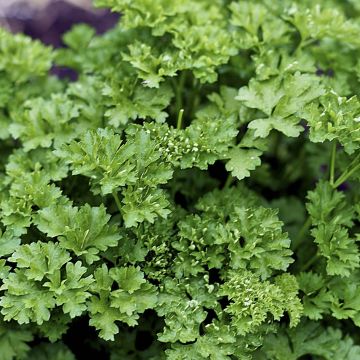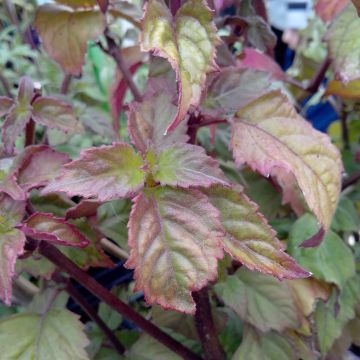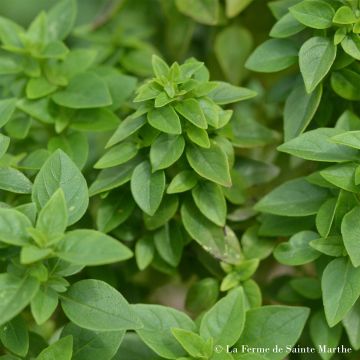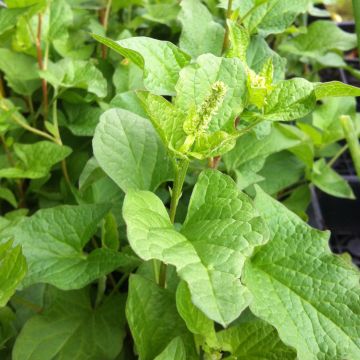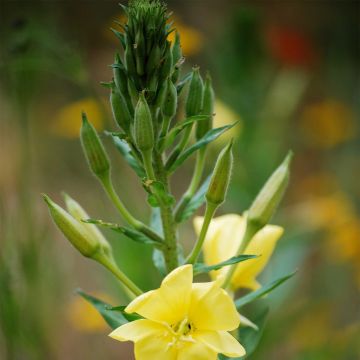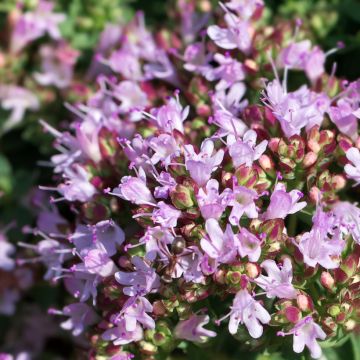

Persil plat - Petroselinum crispum var. neapolitanum
Petroselinum crispum var. neapolitanum
Petroselinum crispum var. neapolitanum
Flat-leaved parsley, Italian parsley
This plant carries a 6 months recovery warranty
More information
We guarantee the quality of our plants for a full growing cycle, and will replace at our expense any plant that fails to recover under normal climatic and planting conditions.
From €5.90 for pickup delivery and €6.90 for home delivery
Express home delivery from €8.90.
Description
Flat Parsley (Petroselinum crispum var. neapolitanum), also known as Naples Parsley, is the most cultivated and appreciated variety in cooking due to the intense fragrance of its flat leaves, rather than curly. It also differs from the usual parsley by its larger development. Parsley is one of the most commonly used aromatic plants, used to enhance salads, saucy dishes, or to make a bouquet garni. Grow it in the vegetable garden or in a pot. Plant from April to September for year-round harvesting.
Parsley, belonging to the Apiaceae family, is one of the most commonly used herbs. This biennial plant, native to the Middle East, is grown as an annual, unless one wishes to let it go to seed and harvest the seeds. It then produces umbels of tiny yellowish-green to white flowers. There are mainly two categories of Parsley: flat Parsley, considered more aromatic, and curly Parsley, which adds a decorative touch to dishes. There is also tuberous Parsley, grown for its foliage and especially for its roots, which are similar to parsnips.
Parsley is rich in vitamins A and C, trace elements, and minerals. In cooking, Parsley leaves can be consumed raw, to enhance salads, or cooked, to add flavour to omelettes, soups, and saucy dishes. Combine Parsley with Thyme, Rosemary, and Bay Leaf to form a bouquet garni, ideal for flavoring slow-cooked dishes. Its finely cut leaves also add a decorative touch to dishes. In terms of flavour, the stems are more aromatic than the leaves.
Harvesting: cut the leaves with a pair of scissors as needed. Harvesting can be done throughout the year. Regular picking stimulates leaf production.
Storage: consume fresh Parsley to fully enjoy its aroma. However, it is possible to freeze or dry Parsley leaves for longer storage. For drying, let the bunches of Parsley dry upside down in a dry place. When the stems become brittle, crumble them and transfer them to an airtight container. Dried parsley is significantly less flavourful than frozen or fresh parsley.
Gardener's tip: to limit watering, we recommend mulching the soil with a mixture of successive layers of grass clippings, if possible mixed with dead leaves. This protection, which keeps the soil moist, also limits weed growth.
Report an error about the product description
Harvest
Plant habit
Foliage
Other Parsley plants
Planting and care
Planting flat parsley is done from April to September. You can grow Parsley in the vegetable garden and/or in a pot.
In the ground: First, grow the young plants if necessary by transplanting them into trays or 10 to 13cm (4 to 5in) diameter pots filled with compost. Place them in a warm and bright location. Water regularly.
Parsley prefers rich soils that are slightly moist, well-drained, and slightly alkaline. Plant it in partial shade or in full sun. A few months before planting, add well-rotted compost by loosening the soil to a depth of 5cm (2in). Space the plants 25cm (10in) apart in all directions. Dig a hole, place the plug plant, and cover with fine soil. Firmly pack and water to keep the soil moist.
Regularly weed and hoe, especially at the beginning of the growing season.
In a pot: Use a sufficiently large pot and place a layer of gravel at the bottom to improve drainage. Fill the pot with a mix of potting soil and garden soil, gently place the plug plant, and cover with soil. Firmly pack and water to keep the soil moist.
During the growing season, water moderately, especially in summer. As winter approaches, protect Parsley with a cloche or a cold frame, or bring it indoors if it is grown in a pot.
Cultivation
Care
Intended location
This item has not been reviewed yet - be the first to leave a review about it.
Herbs
Haven't found what you were looking for?
Hardiness is the lowest winter temperature a plant can endure without suffering serious damage or even dying. However, hardiness is affected by location (a sheltered area, such as a patio), protection (winter cover) and soil type (hardiness is improved by well-drained soil).

Photo Sharing Terms & Conditions
In order to encourage gardeners to interact and share their experiences, Promesse de fleurs offers various media enabling content to be uploaded onto its Site - in particular via the ‘Photo sharing’ module.
The User agrees to refrain from:
- Posting any content that is illegal, prejudicial, insulting, racist, inciteful to hatred, revisionist, contrary to public decency, that infringes on privacy or on the privacy rights of third parties, in particular the publicity rights of persons and goods, intellectual property rights, or the right to privacy.
- Submitting content on behalf of a third party;
- Impersonate the identity of a third party and/or publish any personal information about a third party;
In general, the User undertakes to refrain from any unethical behaviour.
All Content (in particular text, comments, files, images, photos, videos, creative works, etc.), which may be subject to property or intellectual property rights, image or other private rights, shall remain the property of the User, subject to the limited rights granted by the terms of the licence granted by Promesse de fleurs as stated below. Users are at liberty to publish or not to publish such Content on the Site, notably via the ‘Photo Sharing’ facility, and accept that this Content shall be made public and freely accessible, notably on the Internet.
Users further acknowledge, undertake to have ,and guarantee that they hold all necessary rights and permissions to publish such material on the Site, in particular with regard to the legislation in force pertaining to any privacy, property, intellectual property, image, or contractual rights, or rights of any other nature. By publishing such Content on the Site, Users acknowledge accepting full liability as publishers of the Content within the meaning of the law, and grant Promesse de fleurs, free of charge, an inclusive, worldwide licence for the said Content for the entire duration of its publication, including all reproduction, representation, up/downloading, displaying, performing, transmission, and storage rights.
Users also grant permission for their name to be linked to the Content and accept that this link may not always be made available.
By engaging in posting material, Users consent to their Content becoming automatically accessible on the Internet, in particular on other sites and/or blogs and/or web pages of the Promesse de fleurs site, including in particular social pages and the Promesse de fleurs catalogue.
Users may secure the removal of entrusted content free of charge by issuing a simple request via our contact form.
The flowering period indicated on our website applies to countries and regions located in USDA zone 8 (France, the United Kingdom, Ireland, the Netherlands, etc.)
It will vary according to where you live:
- In zones 9 to 10 (Italy, Spain, Greece, etc.), flowering will occur about 2 to 4 weeks earlier.
- In zones 6 to 7 (Germany, Poland, Slovenia, and lower mountainous regions), flowering will be delayed by 2 to 3 weeks.
- In zone 5 (Central Europe, Scandinavia), blooming will be delayed by 3 to 5 weeks.
In temperate climates, pruning of spring-flowering shrubs (forsythia, spireas, etc.) should be done just after flowering.
Pruning of summer-flowering shrubs (Indian Lilac, Perovskia, etc.) can be done in winter or spring.
In cold regions as well as with frost-sensitive plants, avoid pruning too early when severe frosts may still occur.
The planting period indicated on our website applies to countries and regions located in USDA zone 8 (France, United Kingdom, Ireland, Netherlands).
It will vary according to where you live:
- In Mediterranean zones (Marseille, Madrid, Milan, etc.), autumn and winter are the best planting periods.
- In continental zones (Strasbourg, Munich, Vienna, etc.), delay planting by 2 to 3 weeks in spring and bring it forward by 2 to 4 weeks in autumn.
- In mountainous regions (the Alps, Pyrenees, Carpathians, etc.), it is best to plant in late spring (May-June) or late summer (August-September).
The harvesting period indicated on our website applies to countries and regions in USDA zone 8 (France, England, Ireland, the Netherlands).
In colder areas (Scandinavia, Poland, Austria...) fruit and vegetable harvests are likely to be delayed by 3-4 weeks.
In warmer areas (Italy, Spain, Greece, etc.), harvesting will probably take place earlier, depending on weather conditions.
The sowing periods indicated on our website apply to countries and regions within USDA Zone 8 (France, UK, Ireland, Netherlands).
In colder areas (Scandinavia, Poland, Austria...), delay any outdoor sowing by 3-4 weeks, or sow under glass.
In warmer climes (Italy, Spain, Greece, etc.), bring outdoor sowing forward by a few weeks.



































